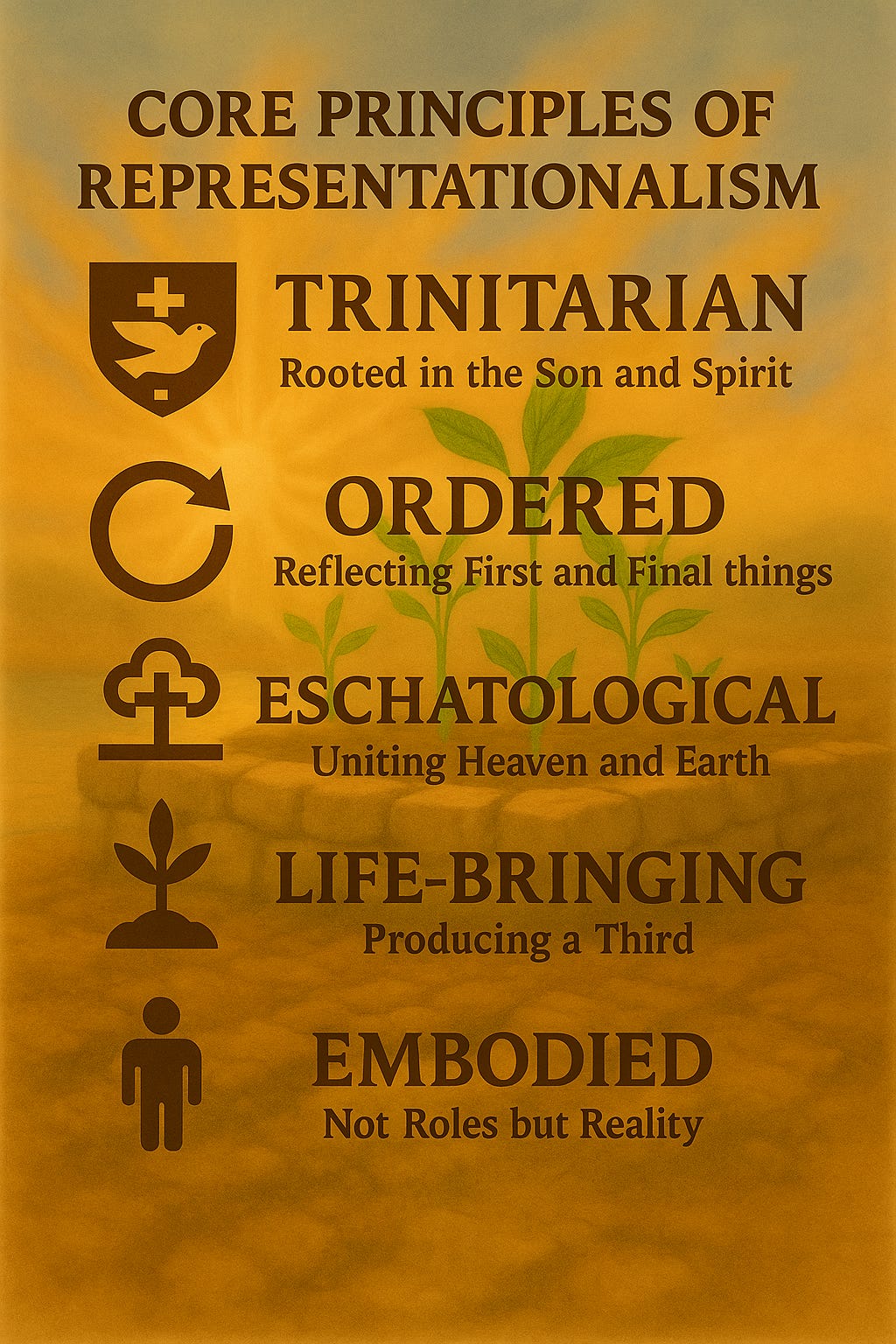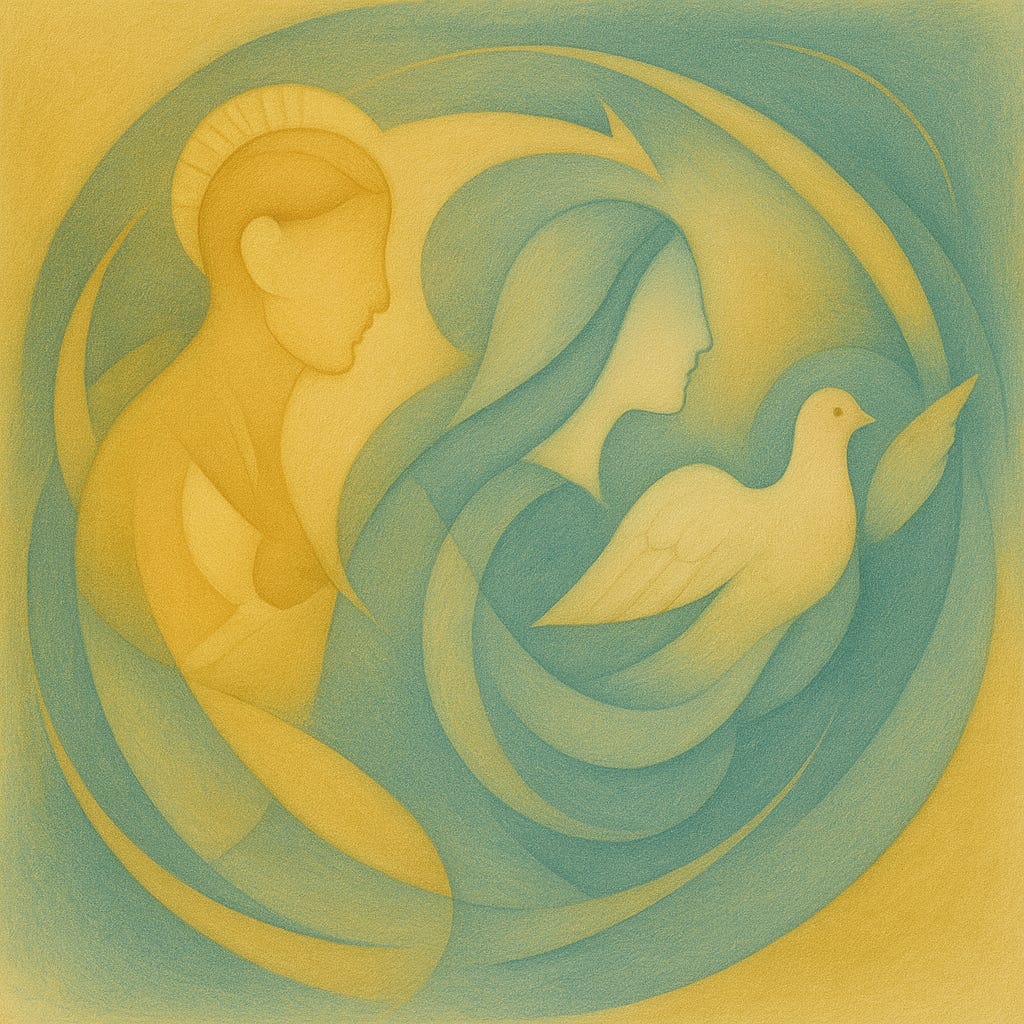Introducing Representationalism
What is it, and is it Different?
It’s important that a new framework is… new.
Many of the criticisms of previous frameworks often have to do with their practical outworkings, but the problem is that these can be dismissed as anecdotal or just examples of poor execution.
The need is for a new thesis! Something that is clearly distinct, which will create different narrative concepts and applications around gender. Representationalism is not an attempt to nuance Complementarianism or Egalitarianism1, because they are built from different principles, as discussed in a previous post. Instead it is a rebuild from the ground up!
Whether Representationalism is right or wrong will be up to the reader (in due time) to decide, but the first task is to make sure that it is clear and its differences are highlighted, which is the goal of the next series of posts.
Interconnected Pieces
Theological frameworks, such as gender paradigms, are the result of interconnected conclusions that lean on each other for support. This means that it’s difficult to pull them apart totally in order to analyze them, because they stand or fall together. This is why this post will lay the key principles of Representationalism all out at once before we unpack each in more depth, because it’s helpful to see how they connect with each other.
It’s also worth noting that competing frameworks share much of the same “building materials” of Scripture and theological truths, which means there will be lots of places of overlap and agreement as well. But just because there are similar conclusions doesn’t mean that there is the same rationale.
For example, Complementarianism teaches male-only eldership, as does the Catholic church, but that doesn’t mean that they followed the same train of logic to get there!2
A few clarifying points before we dive in:
Just because parts of various paradigms are correct does not mean that the paradigm is correct.
Complementarianism isn’t a synonym for “conservative”, but is a paradigm that has a specific set of principles behind it.
One way to appreciate this is to consider that Christian Patriarchy is a different “conservative” paradigm than Complementarianism, even though they have some overlap.3
Having a shared set of principles can still lead to different conclusions in application, which is why there is a spectrum of Complementarian and Egalitarian approaches (“hard vs. soft” etc.), and there could be a spectrum of Representationalist approaches as well.
Core Principles
Ok enough throat clearing!
Leaning on the work of Anna Anderson and others, and teased in the previous post, I think the headwaters of Representationalism can be organized around the following five principles:
Let’s briefly unpack these, with more unpacking in future posts!
1. Gender and the Trinity: Redux
As we covered in a previous post, Complementarianism launched with a novel insight; women uniquely imaged the Triune God! At first blush, this felt like a huge progression from most of church history, which typically saw women imaging creation and men imaging the creator.
The Complementarian instinct was sound; the Triune God we worship created his image in two kinds, male and female, as a way to represent himself on earth in the “living statuaries” of Adam and Eve. Scripture says plainly that we are his own image (not the image of a divine council of angels or of creation), and that we image him in both our unity (“let us make man”) and in our diversity (“male and female he created them”)
Then God said, “Let us make man in our image, after our likeness”…
So God created man in his own image,
in the image of God he created him;
male and female he created them. -Gen. 1:26-27
Early Complementarians had the right idea, but the wrong thesis.
In contrast to gender representing the Father and the Son in their supposed relationship of authority and submission, or gender just representing God in general but without distinction, Representationalism posits that gender's divine referents are the persons of the Son and the Spirit.
2. Ordered Equality
Representationalism also has an approach to understanding the “ordering” of our genders that is distinct from the current options.
Complementarianism typically frames up Eve as Adam’s “ezer” or help, in the sense of her being his second in command for his mission. This creates endless “Batman and Robin” style illustrations for the role of women, such as women riding on the back of a tandem bike, or women as shield bearers, or even more extremely, this couplet of Doug Wilson, “The man was created for the garden, and the woman was created for the gardener”4.
Egalitarianism, while emphasizing full equality of purpose and mission between male and female, loses the “ordered-ness” of gender, and cannot compellingly narrate the uniqueness of their callings.
For Representationalism, Eve as second does not mean secondary, like an assistant, nor does it mean superior. Instead, as the Son's work precedes the work of the Spirit in a way that does not detract from their total equality and essentialness, the masculine story has a "first-ness" to it, and the feminine story has a "final-ness"to it. These stories fit together in an ordered way that maintains both distinctness and equality.
3. Gender and the Union of Heaven and Earth
Similarly, we see a pattern of gender mapping onto "heaven and earth" realities, what Anna Anderson calls the “eschatological” component of gender.5 What this means, in plain(er) English, is that Adam (and his kin) represent the journey towards the heavenly city of Zion, and Eve (and her kin) represent the destination. The union of the two represent the final union of heaven and earth on the last day.
As Anna Anderson puts it,
“The woman is associated not with the earth in its press heavenward through the work of obedience, but the heavenly goal of that work, Sabbath rest.”
This doesn’t imply that women are holier than men or have no journey to undertake, but that we represent different parts of the story that are true for all of us!
Adam (whose name means “earth”), is made from dust outside of the Garden of Eden and is brought into it. Eve (whose name means “life”), is made inside of the Garden of Eden from the side (tsela in Hebrew) of Adam, a word mostly used in reference to the side of sacred objects like the ark, tabernacle, and temple.6 Their corresponding differences represent work and rest, and their union represents the life of the world.
4. Rivers of Living Water
In John 7:37-38, Jesus stands up at the last day of the Feast of Booths and shouts to the crowd,
“If anyone thirsts, let him come to me and drink. Whoever believes in me, as the Scripture has said, ‘Out of his heart [or better, “womb”7] will flow rivers of living water.’” (Now this he said about the Spirit, whom those who believed in him were to receive.)
What is Jesus referring to?
Jesus is pointing back to Ezekiel’s vision of a future temple in Ez. 40-47, and saying that his people are the fulfillment of this vision! In Ezekiel’s vision, the perfected, idealized temple is rebuilt, and once it is complete, a river of water begins to flow from it to the east towards the unredeemed world, towards Babylon herself.
Jesus is saying that we are that new temple, he is the foundation and cornerstone, and the river of the Spirit that will fill us up and then flow from us is like the River of Life in Ezekiel. Its waters (the work of the Spirit) will bringing healing and restoration to a lost and dying world.
What he is saying could be summarized like this:
Jesus→The New Temple→ The River of Life
Or more abstractly, like this:
The Son→ The Spirit-Place→ The Spirit’s Work
Ok great, but what does that have to do with gender?
In contrast to the Complementarian and Egalitarian focus on only narrating the binary of male and female8, Representationalism holds that the story of gender is not correctly understood until the telos, or goal, is rightly named as the “3rd thing” that the motifs bring about!
In other words, the story of gender only makes sense when you meet the metaphorical “baby”, which is the life-bringing result of the motifs operating in ordered harmony.
And when you meet the metaphorical “baby”, you realize that the feminine story is perhaps not best described as metaphorical shield-bearing, or metaphorically pedaling on the back of a tandem bike, but as metaphorical life-bringing! Which leads to perhaps the biggest differentiator of all:
The surprising plot twist in Representationalism is that the mission flows from the feminine motif.
This is different indeed.
This will take some unpacking in future posts, but to summarize:
The masculine story is essential because the foundation is essential; this story comes first.
The feminine story is essential because the foundation is (metaphorically) barren when left alone; this story comes second, and through it we reach the goal.
Perhaps we can help Doug Wilson’s couplet by adding a phrase:
“The man was created for the garden, and the woman was created for the gardener, but the meaning of life isn’t gardening!”
Gender Patterns
Throne→ City/Temple→ River of Life
Vine→ Branches→ Fruit
Christ→ Church→ The Redemption of the World
Summarized by:
Son→ Spirit-Place → Spirit’s Work
Represented by:
Husband→ Wife→ Baby
5. Gender as an Embodied Reality
Let’s end on one we all (mostly) agree on!
In agreement with more recent Complementarian and Egalitarian writings910, but in contrast to secular understandings, Representationalism emphasizes gender’s starting point is embodiment, not roles.
Gender is an embodied reality. Our bodies are metaphors, or types, for larger stories.
We are much more than the roles we play, and even if men and women do the same "role", the effect it has is very different because of the reality of our bodies.
Focusing too heavily on roles can be counterproductive, because it makes it sound as though gender is only the roles we play. This, as Aimee Byrd points out, is in line with transgender ideology, because it focuses our identity on our actions instead of our essence.
Our triune God has given us different bodies to represent different elements of who he is, which are more than (though not less than) the roles we play. Christians, more than anyone, need to be able to celebrate the goodness and the difference of our gendered bodies.
Hopefully you can see glimpses of how the pieces of Representationalism hold together, and how they engage the biblical story.
As always, thanks for reading, and make sure to subscribe so you don’t miss the next post!
Nor is it a third way approach! Third way language implies that the new framework is “purple” in relation to the “red” and “blue” initial frameworks, with some blending and compromising having happened. No doubt there have been many helpful attempts to find the purple space in between Complementarianism and Egalitarianism, but I’d like to think that Representationalism is “green” in relation to the blue and red of those options!
The founding theses are different enough, I believe, to conclude that it is a new framework. This is also why I think it deserves a new name (instead of calling it Complementarianism 2: Electric Boogaloo etc.); it is not a reframing of conclusions, but a reframing of first principles in gender theology/ theological anthropology.
Here’s an example Catholic argument, which, unsurprisingly, spends a good bit more time talking about Mary.
In fact, perhaps Christian Patriarchy is even more “conservative”, if conservative is a euphemism for traditional. Yet the goal is not to be conservative, but to be correct in our understanding of Scripture. It is essential to realize that one can miss on both sides of the truth.
https://dougwils.com/books-and-culture/s7-engaging-the-culture/the-natural-use-of-the-woman.html
https://biblehub.com/hebrew/6763.htm
https://biblehub.com/greek/koilias_2836.htm
It was recently pointed out to me that Tim Keller doesn’t mention children in “The Meaning of Marriage”!
Such as On the Meaning of Sex by J. Budziszewski, as well as The Genesis of Gender by Abigail Favale!
Another good one here! https://www.thegospelcoalition.org/article/not-rush-roles/












Great overview John. Re: criticisms of applications, that’s part of why I have loved Anna’s work and am interested in yours: ISTM that a focus on application drove the development of both comp and egal, where as representationalism starts from entirely different questions. I look forward to diving into the details!
Thank-you for pointing out that the Greek word for ‘heart’ is better translated as ‘womb’.
I’m not a Hebrew scholar but I love Robert Alter’s Hebrew Bible Translation and Commentary. It has led me to realise that there are several Hebrew words that have somewhat overlapping meanings : belly, abdomen, bowels, womb, seat of generation, kidneys, reins, inward parts, innermost thought, emotions, inner chamber, and even entrails (of sacrificial animals).
The semantic range is broad!
I’ve dug into these Hebrew words using multiple translations, including the NetFull2 translation on Stepbible.org, Blue Letter Bible, and Robert Alter’s notes.
I’ve found two Hebrew words that can mean womb or seat of generation: H4587 and H990. And
I’ve made a pencil list of each occurrence of those words in the Hebrew Bible.